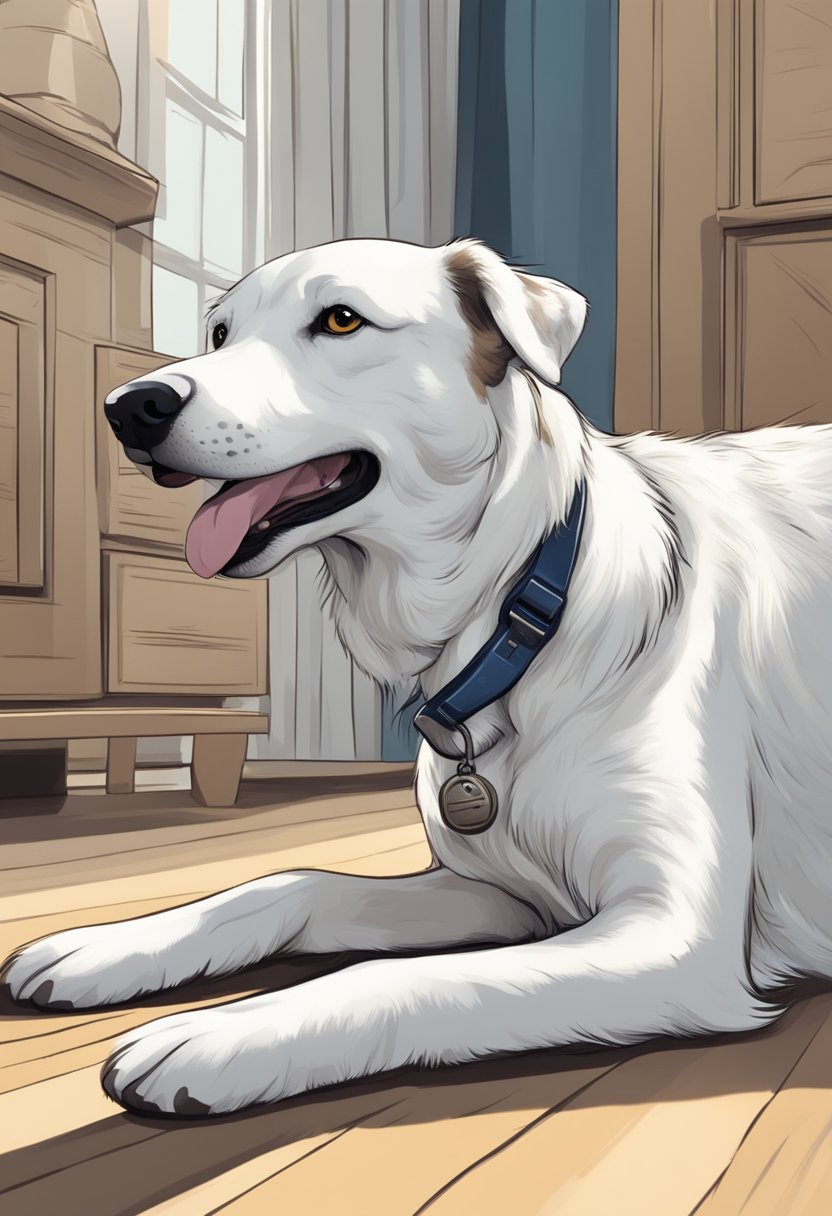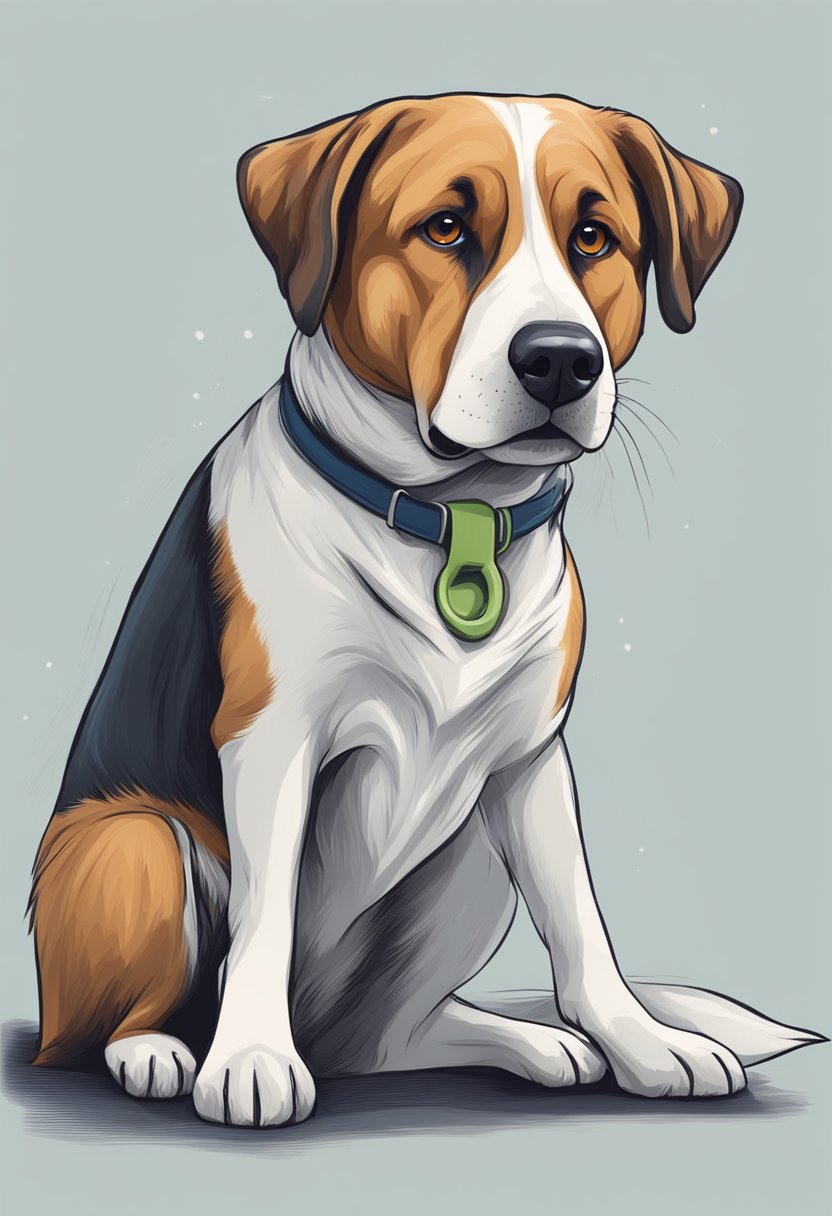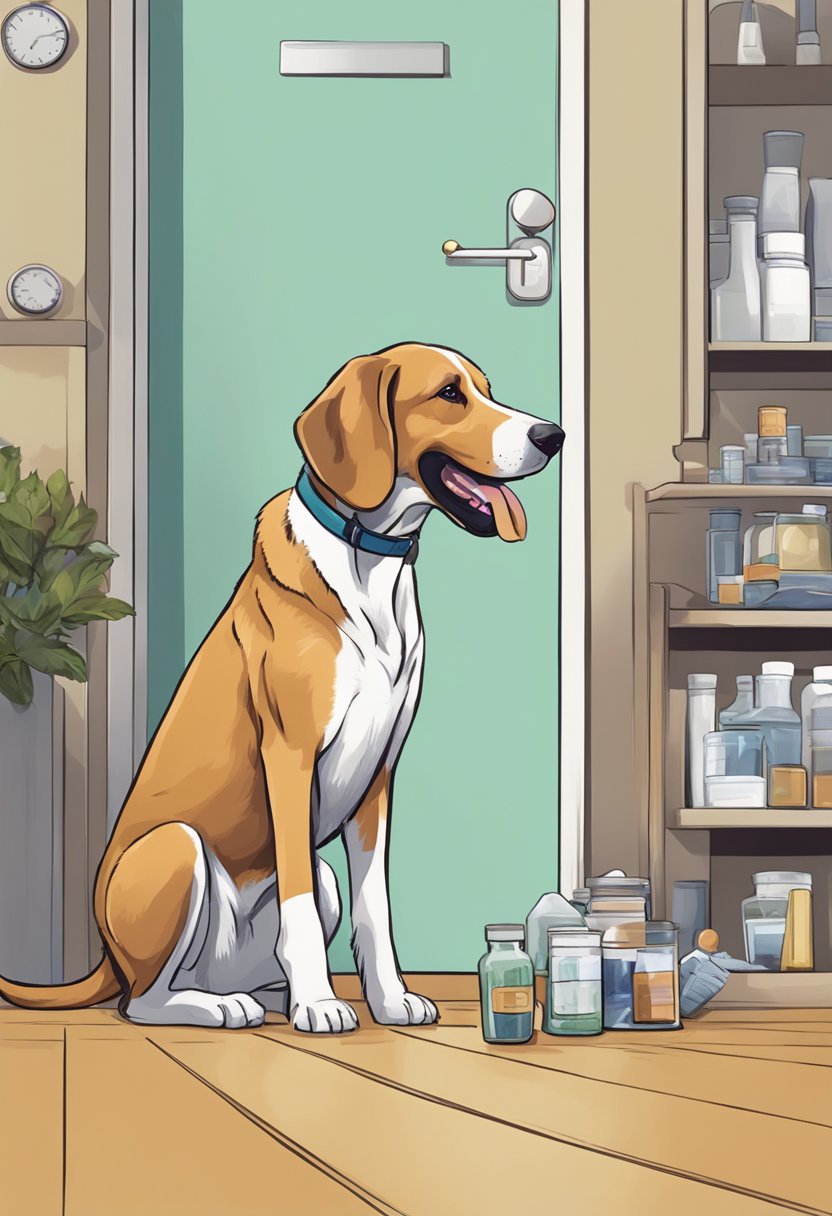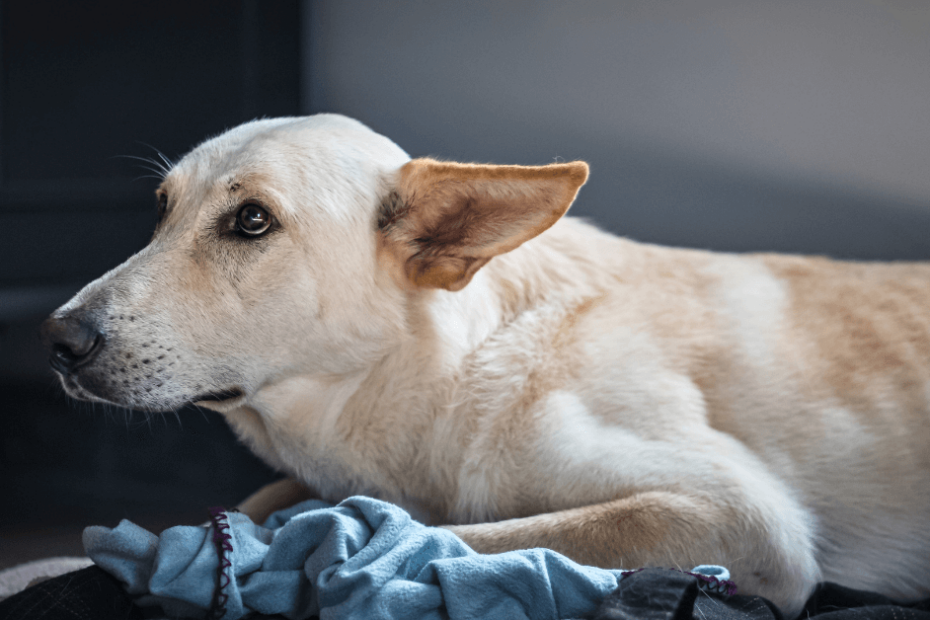It’s not uncommon for dogs to experience anxiety. Dogs are social animals, and they can feel stressed or anxious in certain situations.
As a dog owner, it’s important to know the signs of anxiety in your pet and how to treat it.
Fortunately, there are several ways to treat anxiety in dogs.
In this post, we’ll cover the different signs of anxiety and how you can best help your pup. Check it out!
Affiliate disclosure: As an Amazon Associate, I may earn commissions from Amazon.com.
Panting and Pacing

Panting and pacing are common signs of anxiety in dogs.
While panting is a normal behavior for dogs, excessive panting can be a sign of an underlying health problem or severe anxiety.
If your dog is panting heavily and pacing restlessly, it may be a sign of gastrointestinal distress, heart disease, neurological disease, respiratory disease, toxicity, or pain.
A dog in pain may display many signs and symptoms, including panting and pacing restlessly.
Your dog may be reluctant to lie down and rest or unable to get comfortable once he does settle.
To help calm your dog, you can try to identify the underlying cause of his anxiety and address it.
For example, if your dog is anxious because of separation anxiety, you can gradually desensitize him to your absence by leaving him alone for short periods of time and gradually increasing the duration.
You can also try providing your dog with a comfortable and safe space, such as a crate or a designated area in your home where he can retreat when he feels anxious.
In addition, you can try to distract your dog from his anxiety by engaging him in activities that he enjoys, such as playing with toys, going for walks, or practicing obedience training.
You can also try using natural remedies, such as lavender oil or chamomile, to help calm your dog’s nerves.
However, it is important to consult with your veterinarian before using any natural remedies to ensure that they are safe and effective for your dog.
By addressing the underlying cause of your dog’s anxiety and providing him with a safe and comfortable environment, you can help him feel more relaxed and calm.
If your dog’s anxiety persists or worsens, you should consult with your veterinarian to determine if there are any underlying health problems that need to be addressed.
Whining or Barking

Dogs communicate through barking, whining, and other vocalizations, but excessive whining or barking may be a sign of anxiety.
When a dog is anxious, they may bark or whine more frequently, and it may be accompanied by other signs of anxiety such as pacing, panting, or trembling.
If a dog is whining or barking excessively, it is important to identify the underlying cause.
It could be due to separation anxiety, fear, or a medical condition.
If the dog is whining or barking due to separation anxiety, it is important to gradually desensitize the dog to being alone.
This can be done by leaving the dog alone for short periods of time and gradually increasing the duration over time.
Providing the dog with a comfortable and safe space, such as a crate, can also help them feel more secure.
If the dog is whining or barking due to fear, it is important to identify the source of the fear and work to desensitize the dog to the trigger.
This could involve counter-conditioning, where the dog is exposed to the trigger in a controlled and positive environment.
In some cases, whining or barking could be a sign of a medical condition, such as pain or discomfort.
It is important to rule out any underlying medical conditions by taking the dog to a veterinarian.
Shivering or Trembling
If a dog is shivering or trembling, it could be a sign of anxiety.
According to WebMD, many things may cause a dog to shiver or tremble, such as fear, excitement, cold, pain, or illness.
However, if the shivering or trembling is accompanied by other signs of anxiety, such as panting, pacing, hiding, or destructive behavior, it could be a sign of a more serious problem.
One way to help a dog with anxiety-induced shivering or trembling is to provide a safe and comfortable environment.
This can include a cozy bed, a quiet room, or a crate. Additionally, providing a source of comfort, such as a favorite toy or blanket, can help reduce anxiety.
Another way to help a dog with anxiety is to provide exercise and mental stimulation.
This can include going for walks, playing fetch, or engaging in training exercises.
Exercise and mental stimulation can help reduce stress and anxiety and promote relaxation.
If a dog’s shivering or trembling persists or is severe, it may be necessary to consult with a veterinarian.
The vet can help determine the underlying cause of the shivering or trembling and recommend appropriate treatment options.
Excessive Licking or Chewing
Excessive licking or chewing is a common sign of anxiety in dogs. Dogs may lick or chew themselves excessively as a way of self-soothing when they are feeling anxious or stressed.
This behavior can lead to hair loss, skin irritation, and infection. Therefore, it is important to address this behavior as soon as possible.
There are several reasons why dogs may start licking or chewing excessively. It could be due to separation anxiety, fear, boredom, or even a medical condition.
It is important to identify the underlying cause of this behavior in order to address it effectively.
One way to help reduce excessive licking or chewing is to provide your dog with plenty of mental and physical stimulation.
This can include daily walks, playtime, and training sessions.
Puzzle toys and chew toys can also help keep your dog occupied and prevent them from turning to self-soothing behaviors.
If the excessive licking or chewing is due to separation anxiety, it may be helpful to gradually desensitize your dog to being alone.
This can involve leaving your dog alone for short periods of time and gradually increasing the duration over time.
It may also be helpful to provide your dog with a safe and comfortable space to retreat to when they are feeling anxious.
In some cases, medication may be necessary to help manage anxiety in dogs. This should always be done under the guidance of a veterinarian.
There are several different types of medications that can be used to treat anxiety in dogs, including antidepressants and anti-anxiety medications.
Avoidance or Hiding
Dogs with anxiety may exhibit avoidance or hiding behaviors. They may try to escape or hide from situations that make them uncomfortable.
This could be triggered by loud noises, unfamiliar people, or other stressful situations.
Some signs that your dog is avoiding or hiding include:
- Hiding under furniture or in a closet
- Refusing to come out of their crate
- Trying to escape through doors or windows
- Trembling or shaking
- Whimpering or whining
If your dog is exhibiting avoidance or hiding behaviors, it is important to address the underlying anxiety.
Ignoring the problem could lead to more severe anxiety and even aggression.
There are several ways to help your dog overcome avoidance or hiding behaviors. One way is to gradually expose them to the trigger in a controlled environment.
For example, if your dog is afraid of loud noises, you could play a recording of the noise at a low volume and gradually increase the volume over time.
Another way to help your dog is to provide a safe and comfortable space for them to retreat to. This could be a crate, a cozy dog bed, or a quiet room.
Make sure your dog has access to water and toys in their safe space.
If your dog’s anxiety is severe, you may need to consult with a veterinarian or a professional dog trainer.
They can help you develop a treatment plan that addresses your dog’s specific needs.
Destructive Behavior

Dogs with anxiety may exhibit destructive behavior, which can include chewing, digging, scratching, and tearing up furniture or other items in the house.
This behavior can be frustrating for owners, but it is important to understand that it is a symptom of their anxiety and not a deliberate act of disobedience.
To address destructive behavior, owners should first identify the root cause of their dog’s anxiety.
Common triggers include separation anxiety, fear of loud noises, and changes in routine or environment.
Once the trigger is identified, owners can work to address it through behavior modification techniques, medication, or a combination of both.
In addition to addressing the root cause of anxiety, there are several steps owners can take to prevent destructive behavior.
These include:
- Providing plenty of exercise and mental stimulation to help alleviate stress and anxiety.
- Providing appropriate chew toys and other items to redirect destructive behavior.
- Using positive reinforcement training techniques to reinforce good behavior and discourage bad behavior.
- Ensuring that the dog has a safe and comfortable space to retreat to when feeling anxious.
By taking these steps and working with a veterinarian or animal behaviorist, owners can help their dogs overcome their anxiety and prevent destructive behavior.
Changes in Bodily Functions
Anxiety in dogs can lead to changes in their bodily functions.
One of the most common signs of anxiety is increased urination.
Dogs may urinate more frequently or in inappropriate places, such as inside the house or on furniture.
This can be a sign of stress or anxiety, especially if the dog is usually well-trained.
Another sign of anxiety in dogs is excessive licking or chewing.
Dogs may lick or chew on themselves, their bedding, or other objects in the environment.
This behavior can lead to skin irritation or infection, and can also be a sign of boredom or frustration.
In some cases, anxiety can also lead to diarrhea or vomiting.
Dogs may also lose their appetite or refuse to eat, which can lead to weight loss and other health problems.
If a dog is exhibiting any of these symptoms, it is important to take them to the veterinarian to rule out any underlying medical conditions.
Owners can help alleviate their dog’s anxiety by providing a predictable and calm environment.
This can include establishing a routine for feeding, exercise, and playtime. Providing plenty of exercise and mental stimulation can also help reduce anxiety in dogs.
In addition, there are several natural remedies and medications that can help alleviate anxiety in dogs.
These include herbal supplements, pheromone therapy, and prescription medications.
Owners should consult with their veterinarian to determine the best course of treatment for their dog’s anxiety.
Excessive Drooling
Excessive drooling is one of the signs that your dog may have anxiety.
According to PetMD, drooling excessively can be a sign of anxiety and stress in dogs.
If your dog is drooling more than usual, it is important to keep an eye on them and observe their behavior.
There are many reasons why your dog might be drooling excessively, including dental disease, nausea, and anxiety.
If your dog is showing other signs of anxiety, such as panting, pacing, or lip-licking, it is important to address the underlying cause of their anxiety.
If your dog is drooling excessively due to anxiety, there are several things you can do to help them feel more comfortable.
One of the most effective ways to treat anxiety in dogs is through behavior modification techniques, such as desensitization and counter-conditioning.
You can also try using natural remedies, such as calming supplements or essential oils.
In addition to these treatments, it is important to provide your dog with a safe and comfortable environment.
This can include providing them with a comfortable bed, plenty of toys to play with, and a quiet space where they can relax.
If your dog’s anxiety is severe, it may be necessary to consult with a veterinarian or animal behaviorist for more advanced treatment options.
Yawning or Lip Licking
Another sign of anxiety in dogs is yawning or lip licking.
While these behaviors are normal in certain situations, such as after a meal or when waking up, they can also indicate stress or anxiety in dogs.
When a dog is feeling anxious, they may start yawning excessively or licking their lips more frequently than usual.
This behavior is often accompanied by other signs of anxiety, such as panting, pacing, or trembling.
One possible explanation for this behavior is that it helps dogs to calm down and release tension.
Yawning, for example, can help regulate the dog’s breathing and heart rate, while lip licking can help them to release stress hormones.
If you notice your dog yawning or lip licking more than usual, it’s important to pay attention to their body language and other behaviors.
They may be trying to communicate that they are feeling stressed or anxious.
To help your dog feel more comfortable, you can try providing them with a safe and quiet space to relax, such as a crate or a designated area in your home.
You can also try using calming techniques, such as massage or aromatherapy, to help your dog relax and reduce their anxiety.
It’s important to remember that every dog is unique, and what works for one dog may not work for another.
If you are concerned about your dog’s anxiety or behavior, it’s always best to consult with a veterinarian or a professional dog trainer for guidance.
Changes in Ears and Eyes
When dogs are anxious, they may show physical signs of discomfort.
One of the most common ways dogs show anxiety is through their ears and eyes.
Dogs may flatten their ears against their head or hold them tightly to the sides of their head, indicating that they are feeling anxious or scared.
Another sign of anxiety in dogs is when they show the whites of their eyes, also known as “whale eye.”
This is when the dog’s eyes are wide open, and the whites of their eyes are visible. This can be a sign that the dog is feeling stressed or uncomfortable.
In addition to whale eye, dogs may also avoid eye contact when they are anxious.
They may look away or avoid looking at their owner, which can be a sign that they are feeling scared or nervous.
It’s important to pay attention to your dog’s body language, especially their ears and eyes, to understand if they are feeling anxious.
If you notice any of these signs, try to remove your dog from the situation or provide a calming environment.
Overall, changes in a dog’s ears and eyes can be an indicator of anxiety, and it’s important to address this issue to help your dog feel more comfortable and relaxed.




